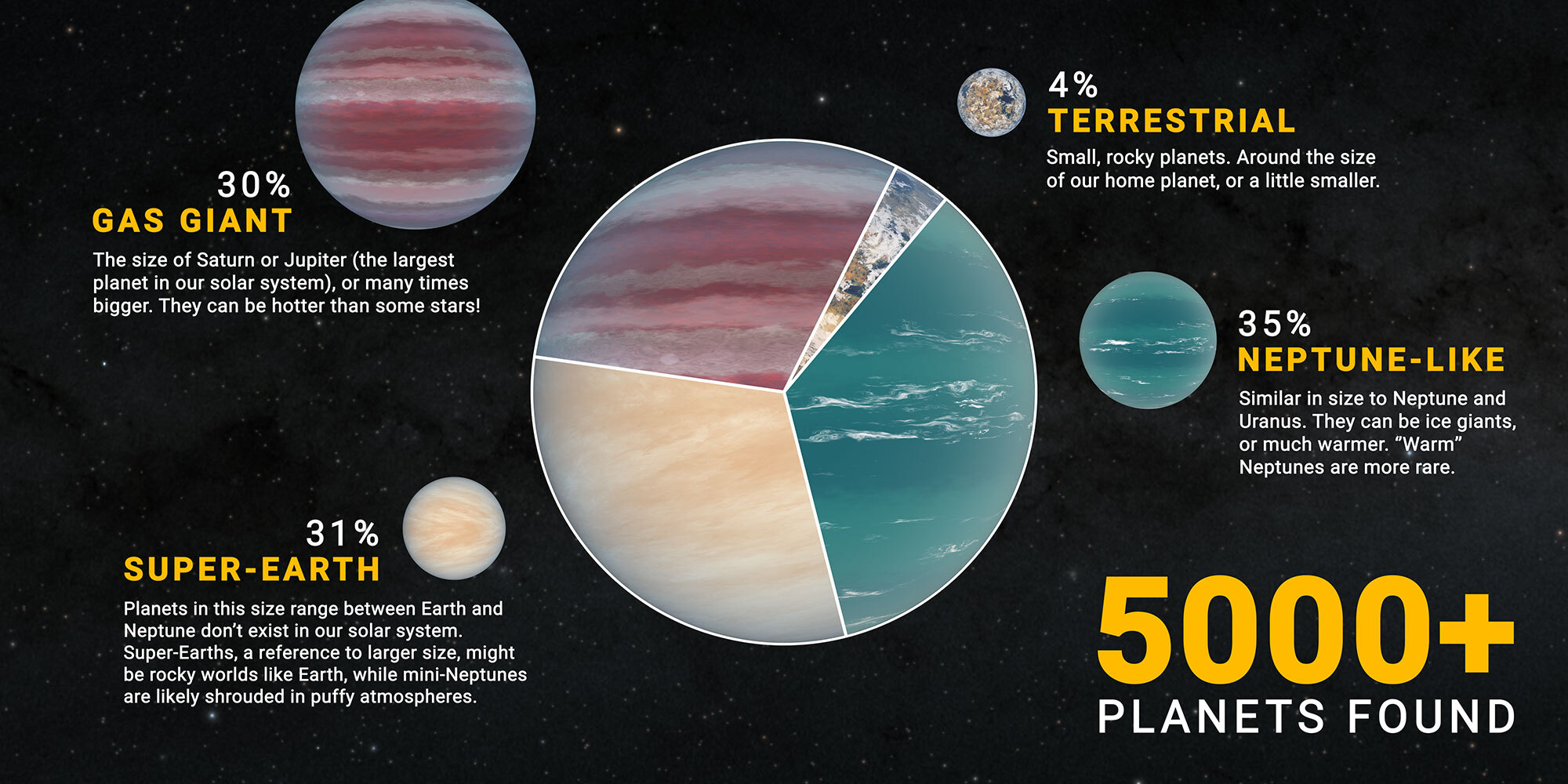28.11.2023

Located throughout the universe, there are billions — possibly even trillions — of exoplanets orbiting around stars of varying shapes, sizes, colors, and more. Like the stars they orbit, exoplanets also come in many different shapes, sizes, and colors, with scientists classifying exoplanets into one of four groups: gas giants, super-Earths, sub-Neptunes, and terrestrial.
Interestingly, among the 5,000+ exoplanets that have been discovered and cataloged by NASA, ESA, and other agencies, there is a strange absence of exoplanets whose sizes are between 1.5 and two times the size of Earth (between super-Earths and sub-Neptunes). In a new study using data from NASA’s now-retired Kepler Space Telescope, scientists may have found evidence for why this size gap exists — the cores of the exoplanets are pushing away their atmospheres from the inside out.
“Scientists have now confirmed the detection of over 5,000 exoplanets, but there are fewer planets than expected, with a diameter between 1.5 and two times that of Earth. Exoplanet scientists have enough data now to say that this gap is not a fluke. There’s something going on that impedes planets from reaching and/or staying at this size,” said the science lead for the NASA Exoplanet Archive and lead author Jessie Christiansen of Caltech.
As mentioned, the gap in exoplanet size lies between the sizes of super-Earths and sub-Neptunes. Scientists believe that the sub-Neptune exoplanets are the possible cause of the size gap, as previous studies have shown that sub-Neptunes are susceptible to atmospheric loss. The exoplanets can lose their atmospheres if they don’t have enough mass, and therefore enough gravitational force, to keep their atmospheres. If this theory of atmospheric loss is true and the sub-Neptunes don’t have enough mass to hold on to their atmospheres, they’d likely shrink to the size of super-Earths, explaining the size gap between super-Earths and sub-Neptunes.
However, the exact process by which sub-Neptunes lose their atmospheres has remained a mystery for years. The two leading theories are core-powered mass loss and photoevaporation. The new Kepler study from Christiansen et al. has shown evidence for the first theory: core-powered mass loss.
As mentioned, core-powered mass loss is the process by which a planet’s core pushes away the planet’s atmosphere from the inside out. The phenomenon occurs when radiation emitted by the planet’s hot core interacts with the planet’s atmosphere, causing the atmosphere to fade away slowly.
The other theory behind atmospheric loss in sub-Neptunes, photoevaporation, occurs when the radiation from the exoplanet’s host star, such as solar wind and flares, blows away the atmosphere around the exoplanet. Dr. Christiansen says, “the high-energy radiation from the star is acting like a hair dryer on an ice cube.”
Scientists believe photoevaporation occurs during the first 100 million years of an exoplanet’s life, while core-powered mass loss is believed to occur much later — around one billion years after the formation of the planet. Either way, if the planet doesn’t have enough mass, it will lose its atmosphere and shrink.
During the study, Christiansen et al. used data from NASA’s K2 mission, an extended mission of the Kepler Space Telescope, which was retired in 2018. The team used data Kepler collected on star clusters Praesepe and Hyades, which are 600 million to 800 million years old, respectively.
Given those exoplanets are thought to be around the same age as their host star, Christiansen et al. knew that if they observed exoplanets within the two-star clusters, the planets should be old enough to have experienced photoevaporation but still too young to have experienced core-powered mass loss. The team predicted that if they saw a high number of sub-Neptunes in the star clusters, they could conclude that photoevaporation had not occurred — meaning that core-powered mass loss would be the leading explanation behind atmospheric loss in sub-Neptunes.
So, what did the team find in the K2 data?
Christiansen et al. found that nearly all of the stars in Praesepe and Hyades still have sub-Neptunes or other exoplanets with atmospheres in orbit around them. After investigating the sizes of the exoplanets around the stars, the team believes that many of the exoplanets still have their atmospheres.
The existence of these exoplanets around these stars differs from the older stars K2 observed, which were older than 800 million years old. Of these older stars, it was found that only 25% have sub-Neptunes in their orbits. Interestingly, the older ages of these stars are closer to the timeframe in which it is thought that core-powered mass loss occurs.
Christiansen et al.’s results allowed the team to conclude that photoevaporation could not have occurred within Praesepe and Hyades, as there would be very few exoplanets with atmospheres within the star clusters if photoevaporation had occurred. This means that core-powered mass loss is the leading theory behind atmospheric loss in sub-Neptunes.
It took Christiansen et al. more than five years to create the catalog of exoplanets that was used in this study. While the team’s findings are certainly telling, there is still a lot to learn about photoevaporation and core-powered mass loss. Furthermore, upcoming studies into sub-Neptunes and atmospheric loss in exoplanets will put Christiansen et al.’s findings to the test.
Quelle: NSF

